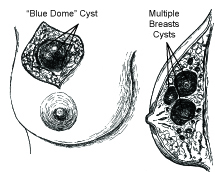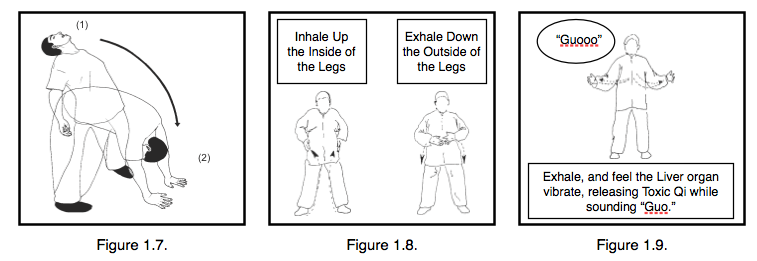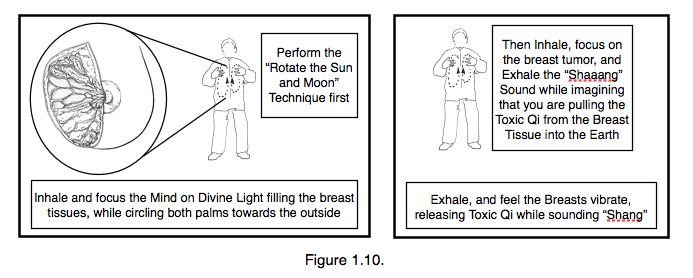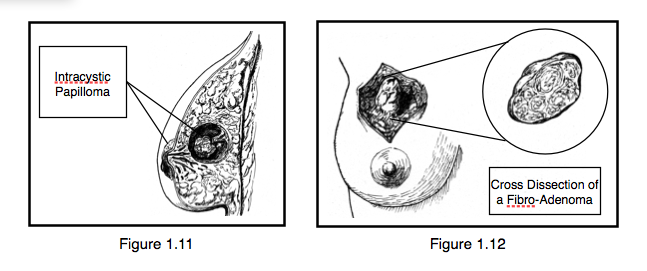Medical Qigong Qi Emission Therapy For Treating Breast Cysts and Tumors
Dec 19, 2024Traditional Chinese Medicine and The Breast

Figure 1.1. The Conception Vessel and Thrusting Vessels are the most important vessels in terms of diagnosing breast pathophysiology
From a Traditional Chinese Medical perspective, the Conception Vessel and Thrusting Vessels exert an important influence on the breast. Both the Conception and Thrusting Vessels extend from the space between the woman’s Kidneys and flow through her Uterus, moving upward into the chest, and connecting with the breasts (Figure 1.1). The Kidney Jing and Liver Qi and Blood also play an important role in breast size and development.
Western Medical Perspective of The Breast
According to Western anatomy, mammary glands (breasts) are present in both sexes but are normally functional only in females. The mammary glands are modified sudoriferous (sweat) glands that are actually part of the skin (part of the integumentary system).
Each mammary gland is contained within a rounded skin-covered breast, located over the pectoralis major and serratus anterior muscles of a woman’s body. Each mammary gland consists of 15 to 20 lobes (compartments), composed of connective tissue and are separated by adipose tissue. Strands of connective tissue known as the “suspensory ligaments of the breast” are extended between the skin and deep fascia, providing support for the breast. The amount of adipose tissue determines the size of the woman’s breasts (Figure 1.2).

Figure 1.2. An Anatomical View of the Breast
Mammary ducts extend to the nipple and expand to form the lactiferous sinuses where milk can be stored. The circular pigmentation of the skin surrounding the nipple is called the areola and contains modified sebaceous (oil) glands. The autonomic nervous system controls the smooth muscle fibers in the areola and nipple, causing them to expand and become erect when stimulated.
Breast Cysts and Benign Tumors
Different Types of Breast Cysts
A breast cyst is a lump or nodule found within the breast tissue. These lumps feel like hard nodules; they are usually painless, round, flat, and mobile. The lumps do not feel hot or cold to touch, the skin color and the size of the lump may vary depending on the patient’s mood changes.
Breast cysts or nodules can be divided into three major categories: Phlegm, Blood Stasis, and Toxic Heat, described as follows(Figure 1.3):
- Phlegm Lumps: Are soft with distinct edges, mobile, and slippery. They are not swollen, and the skin surface around the area is lighter in color.
- Blood Stasis Lumps: Are hard, immobile nodules. The skin surface around the surrounding area is purple.
- Toxic Heat lumps: Are hard, immobile, with indistinct edges. The skin surface of the surrounding area is indented and red.

Figure 1.3. The Three most common types of breast cyst formation
Etiology of Breast Cysts
Western Medicine maintains that the cause of breast disorders (Chronic Cystic Mastitis) are due to a hormonal imbalance of an excessive estrogen secretion and a progesterone insufficiency. This excessive estrogen secretion stimulates the growth of the glandular lobes and fibrous tissues of the breasts, creating the formation of the breasts cysts.
However, Traditional Chinese Medicine also explores the spiritual, emotional and mental conditions that support the energetic function of the body’s internal organ systems. For example, Chronic Cystic Mastitis is believed to be caused by the patient’s Liver and Spleen energetic system being affected by stress, poor diet, worry, anger, and depression. Once the Spleen Qi is weakened, it naturally disrupte the free-flow of the Liver Qi. This leads to conditions of nodules created due to both Qi and Phlegm Stagnation. Long term Qi Stagnation eventually leads to the accumulation of Phlegm and Stasis of Blood. According to the Yi Zong Jin Jian (The Golden Mirror of Medicine), “Hard nodes within the breast are caused from retention, binding and stagnation of Qi in the Liver and Spleen channels. In mild cases, the nodes take the form of the mammary lotus (Ru Lian), in severe cases, they take the form of the mammary rock (Ru Yan).
Breast cysts can be internally induced especially by suppressing the emotions of grief and anger (generally mother issues are relate to the left breast and Lung, while father issues are relate to the right breast and Lung). These type of cysts are characterized by their process of development; they generally start small and increase in size after several months. According to the Fu Ren Da Quan Liang Fang (Complete Effective Prescriptions for Woman’s Diseases), “A woman who has been in a chronic state of anxiety and depression will have obstruction of the Spleen Qi and Rebellious Liver Qi. This will gradually give rise to dormant breast nodes.”
From a Traditional Chinese Medical perspective, the fibrocystic changes that can occur within a woman’s breast tissue are commonly divided into three levels of benign breast cyst disorders:

Figure 1.4. Examples of Chronic Cystic Mastitis, and the three stages of their formation (Inspired by the artwork of
Dr. Frank H. Netter).
- Level-1 Chronic Cystic Mastitis (Mastodynia): This is considered the first stage of mammary dysplasia and includes the development of small benign lumps or nodules. These cysts can become tender with glandular swelling.
- Level-2 Chronic Cystic Mastitis (Adenosis): This is considered the second stage of mammary dysplasia and includes the development of multiple nodules in one or both breasts (usually distributed in the superior and lateral areas of the breast). These cysts can become cord-like and nodular with “saucer edges.”
- Level-3 Chronic Cystic Mastitis (Cystic Disease): This is considered the third stage or late variety of mammary dysplasia. When these larger cysts are exposed during operation they have a characteristic “Blue Dome” that bulges into the subcutaneous fat of the patient’s breast (Figure 1.4).
Treatment Protocol for Breast Cysts

Figure 1.5. The Qigong doctor will stimulate specific points to initiate channel flow and remove stagnation.
The Medical Qigong doctor’s treatment will focus on eliminating the stagnation and removing the Phlegm. This is accomplished through using Qi Purging and Dispersing techniques, described as follows:
- After clearing the diseased area of Toxic Qi, the Medical Qigong doctor uses the Sword Fingers technique to stimulate CV-17, St-18, Lu-1, UB-18, and UB-21 points to open the points along the Liver, Lung, and Stomach Channels (Figure 1.5).
- The doctor then emits Qi, using the Vibrating and Shaking Hand techniques, in conjunction with the projected “Shang” sound. This is used in order to disperse the energetic stagnation that supports the cyst formation.
- The doctor then applies the Dragon Mouth manipulation to dredge the patient’s body by pushing, pulling, and leading the Stagnant and Toxic Qi down her Lung Channels and out the arms. The Stagnant and Toxic Qi is also led down the Liver, Gall Bladder and Stomach Channels and out her legs (Figure 1.6).

Figure 1.6. After purging the Toxic Qi from the patient’s upper body, the Medical Qigong Doctor will continue to disperse the Toxic Qi from her lower abdomen, leading the Qi down the patient’s leg and out her St-36 points.
Homework Prescription Exercises
- Jing Point Therapy: The patient is given Jing Point Therapy and kneading the surface and surrounding tissue of the cyst once a day. Generally, the patient will stimulate the CV-17, St-18, and Lu-1 Jing points to open the channel flow along the Liver, Lung, and Stomach Channels (refer back to Figure 1.5).
- Dry Crying: Have the patient practice the “Dry Crying” exercise for a period of 15 minutes twice a day (Figure 1.7).
- Healing Sound “Guo”: Have the patient prepare the Liver area for Healing Sound Therapy with the “Ascend the Yin and Descend the Yang” exercise (Figure 1.8). Then, exhale the “Guo” purging sound to remove Liver Stagnation and Heat 36 times. This exercise is to be practiced five times a day to purge Liver Stagnation and Liver Heat (Figure 1.9).

Figure 1.7. The “Dry Crying” Prescription Exercise
Figure 1.8. The Ascend the Yin and Descend the Yang Medical Qigong Channel Purging Technique.
Figure 1.9. To Purge Liver Stagnation use the healing sound “Guo”
4. Healing Sound “Shang”: Have the patient prepare the tissue area with the “Sun and Moon Rotating Technique” exercise. End with the hands placed above the tumor area, then, have the patient practice the healing sound “Shang” for 18 breaths, then the descending “Shang” sound for 18 breaths 5 times a day to further dissolve the cyst, and to dispel the Toxic Qi out the breasts (Figure 1.10).

Figure 1.10. For Breast Cysts, perform the “Rotate the Sun and Moon” Technique first; Then perform the healing sound “Shang” for 18 breaths

Figure 1.11. Example of a Benign Intracystic Papilloma. (Inspired by the original artwork of Dr. Frank H. Netter).
Figure 1.12. Examples of a Benign Fibro-Adenoma. (Inspired by the original artwork of Dr. Frank H. Netter).
Benign Tumors: Intracystic Papillomas
A Benign Intracystic papilloma is a soft, movable epithelial tumorous growth occurring within the mammary duct or cystic gland (Figure 1.11). An intracystic papilloma is an encapsulated tumor, surrounded by Blood or Body Fluid.
Benign Tumors: Fibroadenomas
A fibroadenoma is considered the most common type of benign breast tumor (Figure 1.12). It is firm, round, and moveable and can cause painful inflammation of the breast skin and underlying tissue.
Etiology of Benign Breast Tumors

Figure 1.13. Etiology of an Emotionally Induced, Chronic, Benign Breast Tumor Formation
Fibroadenoma and Benign Intracystic Papillomas are caused by Qi and Blood stagnation, resulting from the stagnation of the Liver or Gall Bladder Qi, which is accompanied by excessive stagnation of Toxic Heat in the Stomach Channels.
Chronic benign tumors can also be caused by the following four conditions (Figure 1.13):
- Liver Fire and Excess Heat burning up the Body Fluids
- Accompanied by Heart and Lung Qi stagnation due to the accumulation of grief, sorrow, stress, exasperation
- Combined with Spleen Qi Deficiency causing Phlegm,
- Or due to a disharmony of the patient’s Thrusting and Conception Vessels.
Treatment Protocol for Benign Breast Tumors

Figure 1.14. After purging the Toxic Qi from the patient’s upper body, the Qigong Doctor will continue to disperse the patient’s Toxic Qi from her lower abdomen, leading the Toxic Qi to flow down the patient’s leg and out her
Stomach-36 points.
- After clearing the diseased area of pathogenic Qi, the Medical Qigong Doctor uses the Thunder Palm technique to disperse
-
After several minutes of targeting the area with the Thunder Palm, the Qigong doctor uses the Spiraling and Circling Energy techniques to circle the tissue areas surrounding the tumor, drawing the pathogenic Qi down and out the patient’s nearest arm via the Lung Channel (Figure 1.14).
- The Qigong doctor then uses Projected Sound Therapy (“Shang” and “Ni”) in conjunction with energetic Pulling and Shaking techniques to release the pathogenic Qi from the patient’s body and to draw it out of the Lung Channels of the arm. Additionally, the doctor must pull and snap each of the patient’s fingers and thumbs to release and disperse the Excess Heat and pathogenic Qi.
- Circle rotate the energy within the patient’s Lower Dantian pulling the Qi down the lower legs and out the St-36 points.
- Finally, the Qigong doctor will fill the Lower Dantian and circle regulate the Governing and Conception Vessels using the Microcosmic Orbit to balance the Yin and Yang energy.
Overview of Treatment
The general treatment for breast diseases, depending on the severity of the condition, is divided into five main components: Medical Qigong Therapy, Medical Qigong Massage, Medical Qigong Prescription Exercises, Jing Point Therapy, and Herbal Formulas.
Medical Qigong Therapy
The doctor’s emitted energy can assist the patient in dispersing stagnations, as well as dissolving breast tumors and cysts. Generally, the doctor’s treatment lasts for a period of three days, and can be indefinitely prolonged and increased in effectiveness if the patient is given additional Medical Qigong Prescription Homework.
Homework Prescriptions
This therapy allows the patient to purge the organs that are found to be the root cause of the disease. In Medical Qigong, the doctor views the patient’s cysts or tumors as a flower. If, through surgery, the top of the flower is plucked from its stem (and the branch, stem, and root cause of the disease is left intact), the tumor or cyst will simply return again. In order to heal the patient’s condition, the doctor must also address the original cause of the disease and destroy the entire support system. The purpose for these prescription exercises is to destroy the disease’s entire energetic root system, in order to deny the opportunity for the tumor or cyst to return.
- Dry Crying: The Dry Crying prescription is given to purge the emotions of grief and sorrow from the patient’s Lungs (Figure 1.15).
- Healing Sound “Guo”: Prepare the Liver area with the “Ascend the Yin and Descend the Yang” technique (Figure 1.16). Then, sound the “Guo” healing sound to purge the Liver Fire (Figure 1.17).

3. Healing Sound “Shang”: Have the patient prepare the tissue area with the “Sun and Moon Rotating Technique” exercise (Figure 1.18). Then, the “Shang” healing sound is given to dissolve the cyst or tumor for 36 breaths 3 times a day.


4. Jing Point Therapy: Specific points are prescribed for the patient to enhance the doctor’s treatments and increase healing potential. The patient is encouraged to stimulate specific areas of the body by emitting Qi while pressing and focusing the intention on the following points:
- The SI-3 point affects the patient’s breast disease caused by Rebellious Qi and Qi depression (Figure 1.19).
- The St-18 point is used for the treatment of breast abscess, breast pain, and scanty lactation. Stimulating this point frees the Qi’s energetic flow locally in the patient’s breast (Figure 1.20).
- The St-36 point is generally used to Regulate the Qi of the patient’s entire body. In the treatment of breast disease, however, it is used to treat pain, swelling and abscess formations occurring within the breasts (Figure 1.21).
- The Sp-6 point is specifically chosen for treating breast cysts and alleviating chest pain (Figure 1.22).
- The GB-21 point (Shoulder Tapping) is prescribed to assist the patient in sinking Liver Qi Heat and is also used for the treatment of breast abscess, breast pain and scanty lactation (Figure 1.23).
5. Energetic Point Therapy: Can be practiced by having patients with Breast tumors shake and point the middle finger of the right hand (using the Soaring Dragon Hand Posture) at the location of the breast tumor (close to the body) while the left-hand faces the other breast (farther away from the body). Visualize Divine healing light from the middle finger dissolving the tumor (like a laser beam). The patient should repeat the sounds “Er-Er-Er-Er” (Figure 1.24). Reverse the hand position for tumors located on the opposite side of the breast. The success of this exercise is dependent on imagining that Divine healing light is purifying and transforming the disease. The image of divine light purifies the Toxic Qi, allowing the clean Qi to become transformed and transported to the other breast. This allows the patient’s Righteous Qi and Yuan Qi to become stronger, which supports the body’s immune system.
6. Fast Walking Therapy: The patient should practice Fast Walking Therapy for 20 minutes a day.
Herbs for Breast Cancer:
The following is a list of herbs (Chinese and internationally known) that are traditionally used in the treatment of Breast Cancer. It is important to consult a licensed acupuncturist, naturopath, or herbalist before taking these herbs. Each individual will require treatments personally based on the diagnosis of her specific constitution and symptoms.
- Astragalus, Astragali membramaceus (Huang Qi)
- Shitake, Lentinus edodes
- Poke, Phytolacca americana
- Burdock, Arctium lappa
- Chaparral Larrea tridentata, Larrea divaricata
- Dandelion, Taraxacum officinale (Pu Gong Ying)
- Honeysuckle, Lonicera japonica (Jin Yin Hua)
- Mistletoe, Viscum album
- Sundew, Drosera rotundifolia
- Red Clover, Tritolium pratense
- Thuja, Thuja occidentalis
- Tumeric, Curcuma longa (Yu Jin)
Chinese Herbal Formulae for Breast Cancer:
The following is a list of herbal Formulae (Chinese and internationally known) traditionally used in the treatment of Breast Cancer. It is important to consult a licensed acupuncturist, or Chinese Herbalist before taking these herbs. Each individual will require treatments personally based on the diagnosis of her specific constitution and symptoms.
To clear Heat from Liver Qi Stagnation: Qing Gan Jie Yu Tang:
Radix Paeoniae lactiflorae…………(Bai Shao)………..5g
Radix Angelicae sinensis……………(Dang Gui)………3g
Radix Ligustici Chuanxiong……….(Chuan Xiong)….3g
Fructus Gardeniae jasmoinoidis…(Shan Zhi Zi)……2g
Cortex Moutan radicis……………….(Mu Dan Pi)…….2g
Radix Bupleuri………………………….(Chai Hu)………..2g
Treat Pain and Clear Qi and Blood Stagnation: Shen Xiao Gua Lou San:
Semen Trichosanthis………………(Gua Lou)…….20-30g
Radix Angelicae sinensis…………(Dang Gui)……15g
Radix Glycyrrhizae uralensis……(Gan Cao)…….15g
Gummi Olibanum…………………..(Ru Xiang)……3g
Myrrha………………………………….(Mo Yao)……….8g
To transform Phlegm, Clear Heat, and Clear Blood Stagnation: Dr. Giovanni Maciocia’s Xiao Yao San variation:
Radix Bupleuri ……………………………(Chai Hu)……………6g
Radix Paeoniae lactiflorae…………….(Bai Shao)…………..6g
Radix Angelicae sinensis………………(Dang Gui)………….6g
Radix Paeoniae rubrae…………………(Chi Shao)…………..6g
Tuber Curcumae………………………….(Yu Jin)………………6g
Radix Salviae miltiorrhizea…………..(Dan Shen)………….4.5g
Rhizoma Curcumae zedoariae………(E Zhu)………………..6g
Herba Leonori heterophylli………….(Yi Mu Cao)………….6g
Fructus Trichosanthis………………….(Gua Lou)…………….6g
Herba Sargassi…………………………….(Hai Zao)……………..9g
Radix Rhapontici seu Echinops…….(Lou Lu)……………….6g
Squama Manitis pentadactylae……..(Chuan Shan Jia)….6g
Pericarpium Citri reticulatae viride..(Qing Pi)……………..6g
Western and Alternative Approaches to Cancer Therapy
In any cancer condition, is important to consult a licensed professional before making any type of life-changing decision. The following is a good web source for up-to-date Western and Alternative approaches to cancer therapy. It was created by Ralph W. Moss, PhD, a leading author and consultant on cancer treatment. The site provides individuals with a detailed explanation of various cancer diagnoses, and up-to-date analysis of standard treatments, as well as extensive information on complementary and alternative medicine worldwide (CAM): The web site is as follows: http://cancerdecisions.com
Don't miss a beat!
New moves, motivation, and classes delivered to your inbox.
We hate SPAM. We will never sell your information, for any reason.

